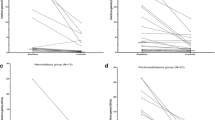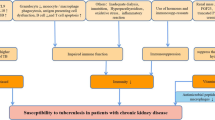Abstract
Background
The majority of active tuberculosis (TB) cases develop from latent tuberculosis infection (LTBI). Since the risk of TB in hemodialysis (HD) patients is particularly high, interferon-gamma release assay (IGRA) for LTBI screening in HD patients is considered important. However, the prevalence and characteristics of LTBI in Japanese HD patients remain obscure.
Methods
We performed an observational cross-sectional study of LTBI using IGRA QFT-3G tests in 118 HD outpatients enrolled at 3 hospitals of varying location and function.
Results
Of the 118 patients, 96 were QFT negative, 7 were QFT indeterminate, 14 were QFT positive, and 1 was QFT judgment impossible. No patient had active TB. Confirmed (QFT positive) and possible (QFT positive + indeterminate) LTBI patients totaled 14 (11.9%) and 21 (17.8%), respectively. The LTBI possible group was significantly older and had a significantly higher rate of nephrosclerosis versus the QFT-negative group. The indeterminate group had a significantly longer HD period. The QFT results were not remarkably affected by other clinical data, including hospital characteristics. The possible LTBI rate increased age-dependently, with higher values from 60 years of age.
Conclusions
The prevalence of LTBI is high in Japanese HD patients, especially from the age of 60 years. Older age was a significant risk factor for LTBI, with prediction difficult using other clinical data. Extended HD may mask IGRA results. Therefore, aggressive screening for LTBI is advised in all HD patients regardless of hospital region or type, especially in patients over 60 years of age or newly commencing HD.



Similar content being viewed by others
References
Number of TB patients(2019–1968) and TB incidence(2019–1962) in prefectures and cities. Tuberculosis surveillance center. https://www.jata.or.jp/rit/ekigaku/toukei/pertinent_material/ Accessed 9 Dec 2020
The prevention Committee and the treatment Committee of the Japanese Society for Tuberculosis. Treatment guidelines for latent tuberculosis infection. Kekkaku. 2014;89:21–37.
Inamoto H, Ino Y, Osawa A. Epidemiological study of high susceptibility and low resistance to tuberculosis in chronic renal failure patients (in Japanese). J Jap Soc Int Med. 1981;70:834–40.
Chia S, Karim M, Elwood RK, FitzGerald JM. Risk of tuberculosis in dialysis patients: a population-based study. Int J Tuberc Lung Dis. 1998;2:989–91.
Sasaki Y, Yamagishi F, Mori T. Tuberculosis in the patients undergoing hemodialysis in Japan, 1996. Kekkaku. 2002;77:51–9.
Lee SS, et al. High prevalence of latent tuberculosis infection in dialysis patients using the interferon-γ release assay and tuberculin skin test. Clin J Am Soc Nephrol. 2010;5:1451–7.
Triverio PA, et al. Interferon-gamma release assays versus tuberculin skin testing for detection of latent tuberculosis in chronic haemodialysis patients. Nephrol Dial Transplant. 2009;24:1952–6.
Rogerson TE, Chen S, Kok J, et al. Tests for latent tuberculosis in people with ESRD: a systematic review. Am J Kidney Dis. 2013;61:33–43.
British Thoracic Society Standards of Care Committee and Joint Tuberculosis Committee, et al. Guidelines for the prevention and management of Mycobacterium tuberculosis infection and disease in adult patients with chronic kidney disease. Thorax. 2010;65:559–70.
Winthrop KL, Nyendak M, Calvet H, et al. Interferon-gamma release assays for diagnosing mycobacterium tuberculosis infection in renal dialysis patients. Clin J Am Soc Nephrol. 2008;3:1357–63.
Japanese association of dialysis physicians. Guidelines for standard hemodialysis procedure and prevention of infection in maintenance hemodialysis facilities (5th edition) http://www.touseki-ikai.or.jp/htm/07_manual/doc/20200430_infection%20control_guideline.pdf. Accessed 17 Apr 2021.
Kanda Y. Investigation of the freely available easy-to-use software ‘EZR’ for medical statistics. Bone Marrow Transplant. 2013;48:452–8.
Japanese Society for Tuberculosis prevention. Guidelines for the use of interferon-gamma release assay by preventive committee, the Japanese society for tuberculosis. Kekkaku. 2014;89:717–25.
Chung WK, et al. Validity of interferon-γ-release assays for the diagnosis of latent tuberculosis in haemodialysis patients. Clin Microbiol Infect. 2010;16:960–5.
Kimura M, et al. Screening for latent tuberculosis infection at the beginning of hemodialysis in our hospital. J Jap Soc Dial Ther. 2018;51:599–605.
Kiba K, et al. Screening for tuberculosis infections in hemodialysis patients by T-SPOT.TB in our hospital. J Nara Dial Med. 2015;20:31–4.
Shu CC, et al. Predictors and prevalence of latent tuberculosis infection in patients receiving long-term hemodialysis and peritoneal dialysis. PLoS ONE. 2012;7:e42592. https://doi.org/10.1371/journal.pone.0042592.
Document table 6:annual trends in the number and incidence of newly registered TB cases. Tuberculosis Surveillance Center https://www.jata.or.jp/rit/ekigaku/index.php/download_file/-/view/3017/ Accessed 9 Dec 2020.
Baek SD, Jeung S, Kang JY. Nutritional adequacy and latent tuberculosis infection in end-stage renal disease patients. Nutrients. 2019;11:1–8.
Passalent L, Khan K, Richardson R, Wang J, Dedier H, Gardam M. Detecting latent tuberculosis infection in hemodialysis patients: a head-to-head comparison of the T-SPOT.TB test, tuberculin skin test, and an expert physician panel. Clin J Am Soc Nephrol. 2007;2:68–73.
Scholman T, et al. Superior sensitivity of Ex Vivo IFN-γ release assays as compared to skin testing in immunocompromised patients. Am J Transplant. 2015;15:2616–24.
Dessein R, et al. Heparin-binding haemagglutinin, a new tool for the detection of latent Mycobacterium tuberculosis infection in hemodialysis patients. PLoS ONE. 2013;8:e71088. https://doi.org/10.1371/journal.pone.0071088.
Hoffmann M, Tsinalis D, Vernazza P, Fierz W, Binet I. Assessment of an interferon-γ release assay for the diagnosis of latent tuberculosis infection in haemodialysis patients. Swiss Med Wkly. 2010;140:286–92.
Bothamley GH, et al. Active case finding of tuberculosis in Europe: a Tuberculosis Network European Trials Group (TBNET) survey. Eur Respir J. 2008;32:1023–30.
Toyota E, Ito K. Tuberculosis screening of foreigners in European, North-American, and Oceanian countries. Kekkaku. 2011;86:685–95.
WHO. Tuberculosis country profiles. Geneva Switzerland, World Health Organization. https://www.who.int/teams/global-tuberculosis-programme/data Accessed 14 Nov 2020.
Stock IM, Division P. Population division, department of economic and social affairs, United Nations. International Migrant Stock 2019. United Nations. https://www.un.org/en/development/desa/population/migration/data/estimates2/estimates19.asp. Accessed 14 Nov 2020.
Tuberculosis in Japan:Annual Report 2020. Tuberculosis surveillance center. https://jata.or.jp/english/dl/pdf/TB_in_Japan_2020.pdf Accessed 18 Apr 2021.
Mori T, Harada N, Higuchi K, Sekiya Y, Uchimura K, Shimao T. Waning of the specific interferon-gamma response after years of tuberculosis infection. Int J Tuberc Lung Dis. 2007;11:1021–5.
Vacher-Coponat H, et al. Natural killer cell alterations correlate with loss of renal function and dialysis duration in uraemic patients. Nephrol Dial Transplant. 2008;23:1406–14.
Author information
Authors and Affiliations
Corresponding author
Ethics declarations
Conflict of interest
The authors have declared that no conflict of interest exists.
Ethical approval
All the procedures performed in studies involving human participants were in accordance with the ethical standards of the institutional research committee at which the studies were conducted (Shinshu University Ethics Committee; IRB approval number 3320) and with the 1964 Helsinki Declaration and its later amendments or comparable ethical standards.
Informed consent
Written informed consent was obtained from all individual participants included in the study.
Additional information
Publisher's Note
Springer Nature remains neutral with regard to jurisdictional claims in published maps and institutional affiliations.
About this article
Cite this article
Ogawa, Y., Harada, M., Hashimoto, K. et al. Prevalence of latent tuberculosis infection and its risk factors in Japanese hemodialysis patients. Clin Exp Nephrol 25, 1255–1265 (2021). https://doi.org/10.1007/s10157-021-02093-w
Received:
Accepted:
Published:
Issue Date:
DOI: https://doi.org/10.1007/s10157-021-02093-w




